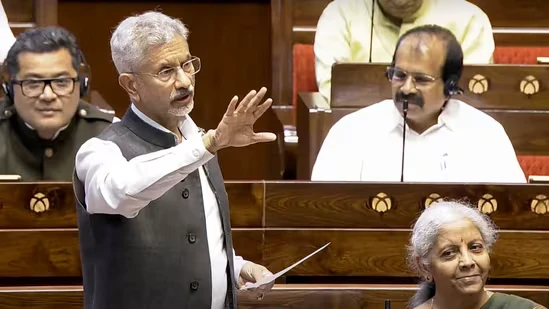In a detailed written response in Parliament, External Affairs Minister S. Jaishankar has raised concerns over a controversial map displayed at an event in Dhaka, which included parts of Indian territory under the notion of a “Greater Bangladesh.” According to the minister, the map was reportedly circulated by an Islamist group named ‘Saltanat-e-Bangla’, allegedly backed by a Turkish non-governmental organization called the ‘Turkish Youth Federation’.
The issue, flagged in response to a starred question raised by Congress MP Randeep Singh Surjewala in the Rajya Sabha, has prompted serious national security concerns within India, with S. Jaishankar stating that the government is “closely monitoring developments” and taking all necessary measures to protect the country’s territorial integrity and interests.
The map and its alleged origins
The incident centers on a display during a cultural exhibition at Dhaka University held on April 14, 2025, to mark Pohela Boisakh, the Bengali New Year. At this event, a map surfaced showing a territorial expansion that included parts of India under the concept of a “Greater Bangladesh.” This depiction triggered concern in India, particularly because of reports attributing the exhibit to the activities of ‘Saltanat-e-Bangla’, a little-known Islamist group believed to be receiving support from the Turkish Youth Federation.
Responding to parliamentary queries, S. Jaishankar clarified that the Indian government has taken note of this development and is actively assessing its implications. He cited intelligence indicating that the group may be attempting to push narratives aimed at redrawing regional boundaries in a way that includes areas from India.
However, questions have also been raised about the legitimacy and existence of the group itself. The Bangladesh government’s own fact-checking platform, BanglaFact, reportedly stated that there is no verifiable presence of ‘Saltanat-e-Bangla’ within the country. According to BanglaFact, the map was part of a historical exhibit referencing the ancient Bengal Sultanate and was not a political statement or campaign. Organizers of the exhibition at Dhaka University have also denied any links to foreign entities or political organizations, asserting that the presentation was part of a cultural event with no separatist intention.
Despite these clarifications from Bangladesh, the matter has gained political and diplomatic significance, especially after it was raised in India’s Upper House. The display of any visual content that appears to undermine India’s territorial sovereignty, regardless of the setting or context, is being viewed with seriousness in New Delhi.
Security concerns and diplomatic engagement
S. Jaishankar’s statement in Parliament also highlighted that the Indian government remains vigilant regarding external influences that may exploit regional sentiments or historical narratives to destabilize current national boundaries. The presence of alleged Turkish backing in this incident has further complicated matters, as concerns grow over increasing Turkish and Pakistani engagement in Bangladesh’s domestic affairs.
Congress MP Randeep Singh Surjewala, who brought up the matter through his question, sought to know whether the Indian government had raised the issue diplomatically with the Bangladesh administration. He also questioned whether the government had assessed the broader security implications of foreign involvement-particularly from Turkey and Pakistan-in Bangladesh and the surrounding region.
While S. Jaishankar did not disclose specific diplomatic exchanges in his reply, he emphasized that any activity or messaging, whether symbolic or organized, that challenges India’s territorial sovereignty would be dealt with firmly. The minister reiterated that India’s security agencies and diplomatic machinery are actively coordinating to track such developments and respond where necessary.
This incident adds to a growing list of geopolitical flashpoints in South Asia where historical and religious narratives are occasionally revived or repurposed to suit present-day ideological objectives. Even though the map displayed at the Dhaka event has been described by local sources as part of a historical reflection, its timing and content have stirred debate over how cultural events can be leveraged for subtle political signaling.
The reference to a “Greater Bangladesh”-a concept with no legal or political basis-has existed on the fringes of nationalist discourse for years. Occasionally resurfacing through social media, fringe political groups, or diaspora communities, it generally lacks support within Bangladesh’s mainstream political narrative. However, any public display or promotion of such maps tends to draw immediate attention from neighboring India, which remains alert to even symbolic acts that could provoke territorial claims or incite unrest.
The involvement of a foreign NGO, especially one based in Turkey, has added a new dimension to the situation. It points to the possibility of ideological alliances between non-state actors across national borders and the potential role of international groups in fueling sensitive narratives in the subcontinent.
At a time when regional security continues to be shaped by complex diplomatic alignments and shifting alliances, such incidents underscore the need for proactive monitoring and robust engagement. India’s concerns lie not only in the symbolism of the act but also in the motivations behind its timing and potential long-term objectives. As the situation develops, the government’s focus remains on maintaining national security and preventing any external or internal efforts to destabilize the territorial status quo.
The post India flags ‘Greater Bangladesh’ map displayed in Dhaka, says Islamist group backed by Turkish NGO is behind it, security being closely monitored | cliQ Latest appeared first on CliQ INDIA.
